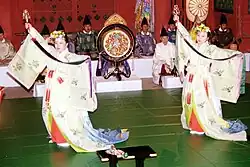神楽鈴
Japanese

| Kanji in this term | ||
|---|---|---|
| 神 | 楽 | 鈴 |
| か Grade: 3 |
らく > ぐら Grade: 2 |
すず Grade: S |
| irregular | kun’yomi | |
| Alternative spelling |
|---|
| 神樂鈴 (kyūjitai) |
Noun
神楽鈴 • (kagura suzu)
References
- Shōgaku Tosho (1988) 国語大辞典(新装版) [Unabridged Dictionary of Japanese (Revised Edition)] (in Japanese), Tōkyō: Shogakukan, →ISBN
- Matsumura, Akira (1995) 大辞泉 [Daijisen] (in Japanese), First edition, Tōkyō: Shogakukan, →ISBN
- Matsumura, Akira, editor (2006), 大辞林 [Daijirin] (in Japanese), Third edition, Tōkyō: Sanseidō, →ISBN
This article is issued from Wiktionary. The text is licensed under Creative Commons - Attribution - Sharealike. Additional terms may apply for the media files.